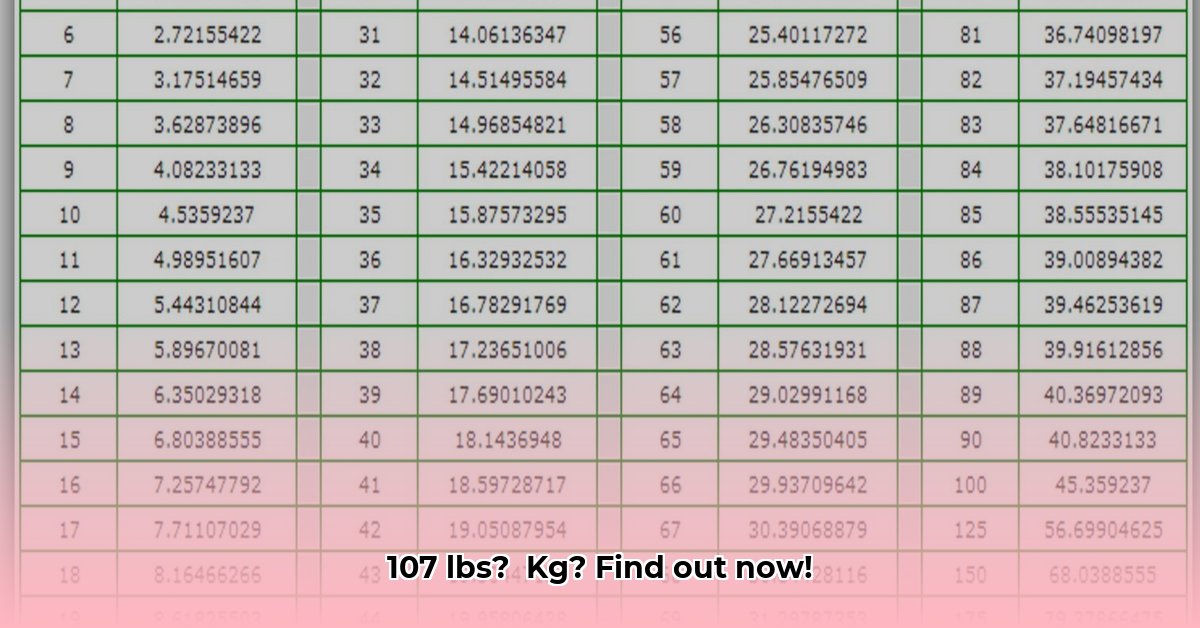Understanding the Conversion
This guide provides a clear and concise explanation of how to convert 107 pounds (lbs) to kilograms (kg), along with practical applications and related information. The conversion factor, based on the internationally recognized standard, is essential for accurate transformations between these two units of mass.
The Conversion Process
The conversion from pounds to kilograms relies on a defined relationship between the two units:
1 pound (lb) = 0.45359237 kilograms (kg)
This conversion factor, established by metrological organizations like NIST, ensures consistency and accuracy in scientific, commercial, and everyday applications.
To convert 107 lbs to kg, simply multiply the weight in pounds by the conversion factor:
107 lbs * 0.45359237 kg/lb ≈ 48.53 kg
Therefore, 107 pounds is approximately equal to 48.53 kilograms. While the exact value is 48.534384 kg, rounding to 48.53 kg is sufficient for most practical purposes. This level of precision balances accuracy with usability in everyday scenarios.
Weight Conversion Chart
For quick reference, the following table provides conversions for weights near 107 lbs:
| Pounds (lbs) | Kilograms (kg) |
|---|---|
| 100 | 45.36 |
| 102 | 46.27 |
| 104 | 47.17 |
| 105 | 47.63 |
| 106 | 48.08 |
| 107 | 48.53 |
| 108 | 48.99 |
| 109 | 49.44 |
| 110 | 49.90 |
| 112 | 50.80 |
| 115 | 52.16 |
This table offers a practical overview of how small weight differences in pounds translate to kilograms, which can be particularly helpful in contexts like health tracking or portion control.
Why Precision Matters
Accurate weight conversions are crucial in diverse fields, from scientific research and medicine to everyday cooking and international commerce.
-
Science and Medicine: Precise measurements are fundamental to scientific experiments and medical dosages. Even slight discrepancies can significantly impact results or patient safety. For example, in pharmaceutical compounding, precise conversions are essential for drug efficacy and to prevent adverse effects.
-
Culinary Arts: In baking and cooking, especially when scaling recipes, accurate conversions ensure consistent outcomes. Ingredient proportions significantly influence the final product, and errors in weight conversion can lead to unexpected results.
-
International Trade and Shipping: Weight conversions are essential in international trade, logistics, and shipping. Accurate weight declarations ensure correct customs duties, shipping costs, and compliance with international regulations.
Mass vs. Weight
While often used interchangeably, mass and weight are distinct concepts. Mass represents the amount of matter in an object, while weight represents the force exerted on an object due to gravity. On Earth, where gravity is relatively constant, we can often use pounds and kilograms interchangeably without significant issues. However, in scientific contexts, it’s important to recognize the subtle difference. Ongoing research in fields like astrophysics explores the relationship between mass, weight, and gravity in different environments, which could lead to refined understanding of these fundamental concepts.
The “2.2 Trick”
For quick estimations, dividing the weight in pounds by 2.2 offers a reasonable approximation of the weight in kilograms. While not as precise as using the conversion factor, this method can be useful for quick mental calculations when precise figures aren’t readily available.
The Importance of Standardized Units
Standardized units, like those maintained by NIST, are essential for accurate and consistent measurements across various applications. They facilitate clear communication and prevent confusion, especially in global contexts. While variations in measurement systems (imperial vs. metric) might persist due to historical and cultural factors, understanding these conversions remains crucial for effective communication and collaboration, particularly in science, engineering, and international trade. Some experts suggest that a unified global system could streamline various processes, but such a shift would likely involve considerable logistical and cultural adjustments.
Future Considerations
As global interconnectedness increases, the need for seamless conversions between different measurement systems will probably become even more prominent. While research on simplifying measurement systems is ongoing, future innovations may lead to new tools and technologies that further streamline these conversions. This could include augmented reality applications that instantly convert units displayed on product labels or smart scales that automatically display weight in both pounds and kilograms. The future of measurement could involve personalized digital tools that adapt to individual needs and preferences.
- Shop Bento Lunch Boxes on Sale Nearby Now - December 7, 2025
- Shop Bento Box for Sale To Find Your Ideal Lunch Container - December 6, 2025
- Lunch Box That Fits Bento Box Neatly for Daily Use - December 5, 2025










